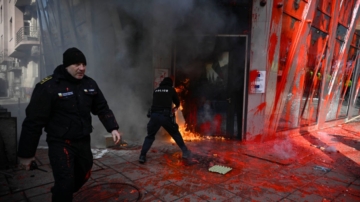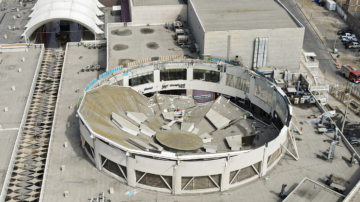设立于东印度加尔各答(Kolkata)的国家矫治收容所(Presidency Correctional Home),将舞蹈纳入矫治课程,让受刑人在狱中接受各种舞蹈训练。参加舞蹈训练的受刑人都表示,这项措施让欢笑重回到他们的生命。
位于印度东方的西孟加拉邦(West Bengal),当地邦政府在过去五年来,持续推动让囚犯享有尊严的牢狱生活,不仅在形式上将监狱的名称,更改为矫治收容所,实际上,更采用各种方法鼓励受刑人从事有意义的活动。舞蹈训练课程,就是其中的方法之一。
担任受刑人舞蹈训练师的阿萝卡萳达‧蕾(Alokananda Ray),亲眼看到了受刑人的巨大转变。对于许多年轻的囚犯而言,蕾不仅仅只是一位舞蹈治疗师,更像是他们的母亲一样。对于受刑人能在舞蹈节庆中,登上舞台公开演出一事,蕾感到很骄傲,也创下了世界首例。为了让受刑人对于舞蹈训练课程更感兴趣,狱方对于舞蹈的种类不作限制。
接受舞蹈训练的受刑人都表示,对他们而言,监狱现在变成了可爱的家,舞蹈不仅能自娱,更让他们的身心受益。
新唐人亚太电视 王士杰 编译
===================================================
SUBCONEARLY-MAY04-INDIA-DANCE THERAPY
SUBCONEARLY: STORY SU703
DANCE THERAPY
KOLKATA, WEST BENGAL, INDIA
MAY 04, 2008
NATURAL WITH ENGLISH SPEECH
DURATION:02:03
SOURCE:ANI
FEED HISTORY:SUBCONEARLY
INTRO: Prisoners take to dance therapy in eastern India.
TV AND WEB RESTRICTIONS~**NONE**~
Prisoners being trained in various performing dances at Presidency jail in
India's eastern Kolkata as part of the reform process.
SHOWS:
KOLKATA (MAY 04, 2008) (ANI-ACCESS ALL)
1.OUTSIDE OF PRESIDENCY JAIL
2.PRISONERS LEARNING DANCE
3.A WOMAN STANDING
4.(SOUNDBITE) (English) ALOKANANDA RAY, TRAINER, SAYING:
"Initially none of the prisoners could move a step. It's a pity
that people don't see the beginning they (people) only see the finished
product. If they did, they would see the tremendous physical transformation,
which can only come through internal transformation."
5.TWO DANCERS DANCING
6.(SOUNDBITE) (English) NAIZAL AXARA, PRISONER, SAYING:
"The greatest thing that I have received from this dance is the
happiness and the smile on my face. I had no smile on my face for the past few
years. This is the greatest thing that I have received."
7.PRISONERS DANCING TOGETHER
8.THREE PRISONERS DANCING IN A ROW
9.A PRISONER DANCING WITH PEOPLE STANDING AROUND
STORY: Prisoners at Presidency jail also known as Presidency Correctional
Home in India's eastern Kolkata are being trained in various performing dances
as part of the reform process.
The state Government in India's eastern West Bengal has been working for
the last five years to offer a respectable life to prisoners. Besides jails
being termed correctional homes, the government is adopting various methods to
engage prisoners in constructive activities and transform all jails into
correctional homes.
Odissi dancer, Alokananda Ray has been training over 50 prisoners in the
jail for the past one year and has witnessed a tremendous change in the
convicts.
Alokananda says she feels she is not simply a therapist but a motherly
figure to the young boys at the prison.
She adds with pride that these prisoners trained by her performed in a
dance festival and it was for the first time in the world that prisoners
staged a public performance.
To generate the interest of the prisoners, Alokananda opted for martial
dance forms like Kalaripattu and Chhau, which have bold music and manly steps
instead of Indian classical dance. But now the jail inmates are open to all
kinds of dances.
"Initially none of the prisoners could move a step. It's a pity that
people don't see the beginning they (people) only see the finished product. If
they did, they would see the tremendous physical transformation, which can
only come through internal transformation," said Alokananda Ray,
trainer.
The prisoners feel that with the learning of dance forms happiness has
returned into their lives.
"The greatest thing that I have received from this dance is the
happiness and the smile on my face. I had no smile on my face for the past few
years. This is the greatest thing that I have received," said Naizal
Axara, Prisoner.
The prisoners acknowledge that the dance has turned their prison cell into
a lively home. They also say that it is the only ray of hope in their lives to
look forward. Besides entertaining them, the rhythm, music and dance movements
have contributed to their mental and physical well-being.
RGDS,
NNNN
位于印度东方的西孟加拉邦(West Bengal),当地邦政府在过去五年来,持续推动让囚犯享有尊严的牢狱生活,不仅在形式上将监狱的名称,更改为矫治收容所,实际上,更采用各种方法鼓励受刑人从事有意义的活动。舞蹈训练课程,就是其中的方法之一。
担任受刑人舞蹈训练师的阿萝卡萳达‧蕾(Alokananda Ray),亲眼看到了受刑人的巨大转变。对于许多年轻的囚犯而言,蕾不仅仅只是一位舞蹈治疗师,更像是他们的母亲一样。对于受刑人能在舞蹈节庆中,登上舞台公开演出一事,蕾感到很骄傲,也创下了世界首例。为了让受刑人对于舞蹈训练课程更感兴趣,狱方对于舞蹈的种类不作限制。
接受舞蹈训练的受刑人都表示,对他们而言,监狱现在变成了可爱的家,舞蹈不仅能自娱,更让他们的身心受益。
新唐人亚太电视 王士杰 编译
===================================================
SUBCONEARLY-MAY04-INDIA-DANCE THERAPY
SUBCONEARLY: STORY SU703
DANCE THERAPY
KOLKATA, WEST BENGAL, INDIA
MAY 04, 2008
NATURAL WITH ENGLISH SPEECH
DURATION:02:03
SOURCE:ANI
FEED HISTORY:SUBCONEARLY
INTRO: Prisoners take to dance therapy in eastern India.
TV AND WEB RESTRICTIONS~**NONE**~
Prisoners being trained in various performing dances at Presidency jail in
India's eastern Kolkata as part of the reform process.
SHOWS:
KOLKATA (MAY 04, 2008) (ANI-ACCESS ALL)
1.OUTSIDE OF PRESIDENCY JAIL
2.PRISONERS LEARNING DANCE
3.A WOMAN STANDING
4.(SOUNDBITE) (English) ALOKANANDA RAY, TRAINER, SAYING:
"Initially none of the prisoners could move a step. It's a pity
that people don't see the beginning they (people) only see the finished
product. If they did, they would see the tremendous physical transformation,
which can only come through internal transformation."
5.TWO DANCERS DANCING
6.(SOUNDBITE) (English) NAIZAL AXARA, PRISONER, SAYING:
"The greatest thing that I have received from this dance is the
happiness and the smile on my face. I had no smile on my face for the past few
years. This is the greatest thing that I have received."
7.PRISONERS DANCING TOGETHER
8.THREE PRISONERS DANCING IN A ROW
9.A PRISONER DANCING WITH PEOPLE STANDING AROUND
STORY: Prisoners at Presidency jail also known as Presidency Correctional
Home in India's eastern Kolkata are being trained in various performing dances
as part of the reform process.
The state Government in India's eastern West Bengal has been working for
the last five years to offer a respectable life to prisoners. Besides jails
being termed correctional homes, the government is adopting various methods to
engage prisoners in constructive activities and transform all jails into
correctional homes.
Odissi dancer, Alokananda Ray has been training over 50 prisoners in the
jail for the past one year and has witnessed a tremendous change in the
convicts.
Alokananda says she feels she is not simply a therapist but a motherly
figure to the young boys at the prison.
She adds with pride that these prisoners trained by her performed in a
dance festival and it was for the first time in the world that prisoners
staged a public performance.
To generate the interest of the prisoners, Alokananda opted for martial
dance forms like Kalaripattu and Chhau, which have bold music and manly steps
instead of Indian classical dance. But now the jail inmates are open to all
kinds of dances.
"Initially none of the prisoners could move a step. It's a pity that
people don't see the beginning they (people) only see the finished product. If
they did, they would see the tremendous physical transformation, which can
only come through internal transformation," said Alokananda Ray,
trainer.
The prisoners feel that with the learning of dance forms happiness has
returned into their lives.
"The greatest thing that I have received from this dance is the
happiness and the smile on my face. I had no smile on my face for the past few
years. This is the greatest thing that I have received," said Naizal
Axara, Prisoner.
The prisoners acknowledge that the dance has turned their prison cell into
a lively home. They also say that it is the only ray of hope in their lives to
look forward. Besides entertaining them, the rhythm, music and dance movements
have contributed to their mental and physical well-being.
RGDS,
NNNN








